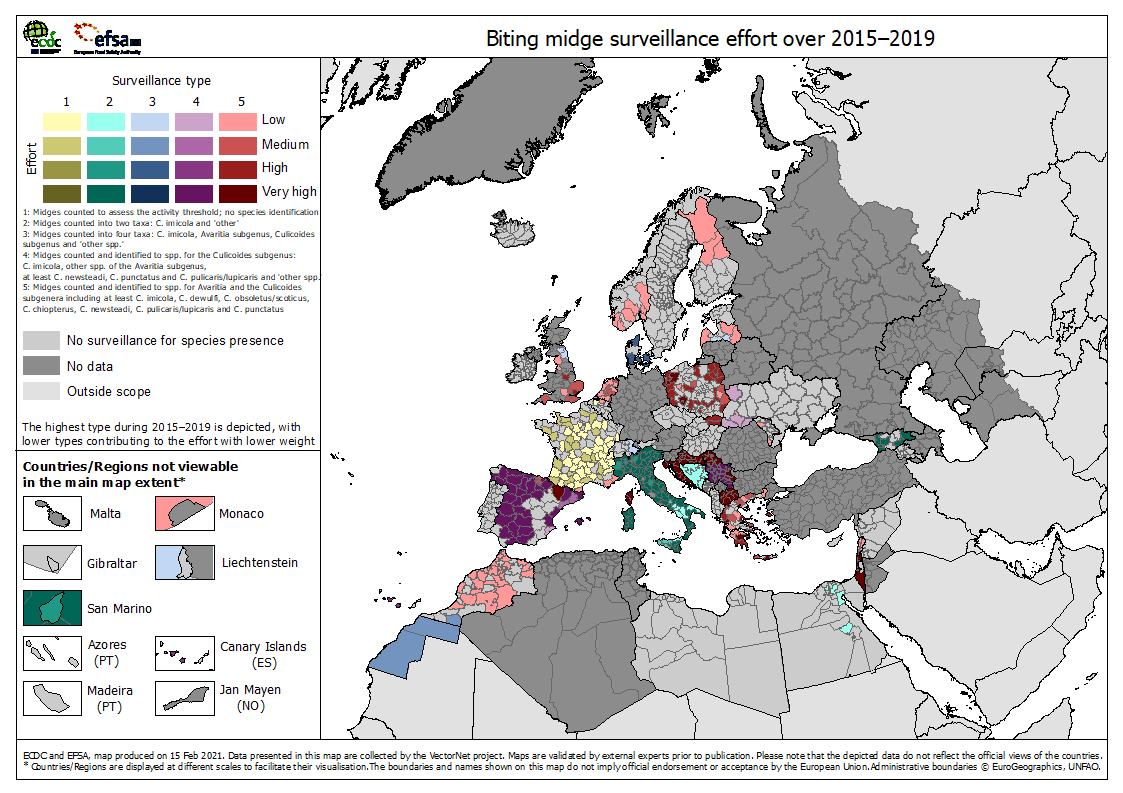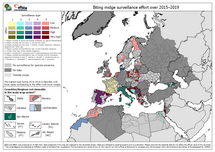Biting midge surveillance effort over 2015–2019
The map 'Biting midge surveillance effort over 2015–2019' shows the surveillance effort per administrative area, by highest surveillance type.

Download

The surveillance categories are:
1 = surveillance, with midges counted only to assess the activity threshold (e.g. more or less than 5 parous females), without species identification
2 = surveillance implemented, with midges counted and identified into two taxa: C. imicola and 'other species'
3 = surveillance, with midges counted and identified into four taxa: C. imicola, other species of the Avaritia subgenus (= 'the Obsoletus group'), species of the Culicoides subgenus (= 'the Pulicaris group') and 'other species'
4 = surveillance, with midges counted and identified to species for the Culicoides subgenus: C. imicola, other species of the Avaritia subgenus (= 'the Obsoletus group'), at least C. newsteadi, C. pulicaris/C. lupicaris and C. punctatus and 'other species'
5 = surveillance, with midges counted and identified to species for at least the Avaritia and the Culicoides subgenera: results including at least C. imicola, C. obsoletus/C. scoticus, C. dewulfi, and C. chiopterus, at least C. newsteadi, C. pulicaris/C. lupicaris and C. punctatus.
The highest surveillance type that occurred in an administrative area during 2015–2019 is depicted, with lower type categories contributing to the effort score with a lower weight. Weights were as follows:
Table: Weights for biting midge surveillance effort
|
|
Highest level |
||||
|
Level |
1 |
2 |
3 |
4 |
5 |
|
1 |
1 |
0.5 |
0.333 |
0.25 |
0.2 |
|
2 |
|
1 |
0.666 |
0.5 |
0.4 |
|
3 |
|
|
1 |
0.75 |
0.6 |
|
4 |
|
|
|
1 |
0.8 |
|
5 |
|
|
|
|
1 |
The data (occurrence of any surveillance activity type during the time period in the administrative unit) was collected by year over 2015 and 2016, and by month over 2017, 2018 and 2019 (The years 2015 and 2016 each carrying 1/12th of the weight of the later years). The score was summed and divided by the maximum score (38) and distributed over the four Effort classes (Low, Medium, High and Very high) according to equal intervals.
Midge surveillance methodology varies considerably according to country. The most widespread method is full species identification (code 5), though this is not the case in Western Europe. Data for midge surveillance activities have been acquired for fewer countries than is the case for the other vector categories, but where data are available, surveillance occurs over a wide range, and is comparatively intensive. Data are still to be acquired for some countries, where information does exist.
Midge surveillance, more than for other vector groups, has varied considerably during the past 15 years. Most Culicoides surveillance activities in the VectorNet geographical area were initiated in response to bluetongue epizootics, and in parts of Spain, due to the African horse sickness outbreaks in 1987–1990. As a result, Culicoides surveillance started in the late 1990s in the Mediterranean countries, and especially in Italy which used Culicoides surveillance as a part of bluetongue contingency plans following the changes in EU regulations.
Midge surveillance is still active in many Mediterranean countries. In Western Europe, however, midge surveillance decreased when bluetongue "disappeared" from non-Mediterranean countries. In central Europe, few surveillance activities have been routinely carried out (except for point surveys for research purposes) since bluetongue was eliminated in 2012. Emergence of SBV and BTV-4 and resurgence of BTV-8 do not seem to have changed the situation, as some countries do not consider that entomological surveillance gives sufficient information for contingency planning. In contrast, however, in 2015, activities were enhanced in eastern Europe after the BTV-4 emergence in Greece/Balkans. Some countries may have decided to deal with Culicoides surveillance activities independently of the bluetongue history.
These very dynamic changes are largely not reflected the data for 2015 to 2019 (a quite recent period compared to the changes in the bluetongue situation). It could be concluded that surveillance priority areas are those where such activities have been reduced as the associated diseases have receded – i.e. much of Europe that is proven to be susceptible to bluetongue and other midge borne diseases. Outside the regions, the main gap in Culicoides surveillance activities is in an area stretching from Libya to Syria, which is an important area of transmission of several bluetongue serotypes and a source of introduction for Europe.
Suggested citation: European Centre for Disease Prevention and Control and European Food Safety Authority. Biting midge maps [internet]. Stockholm: ECDC; 2021. Available from: https://ecdc.europa.eu/en/disease-vectors/surveillance-and-disease-data…”



